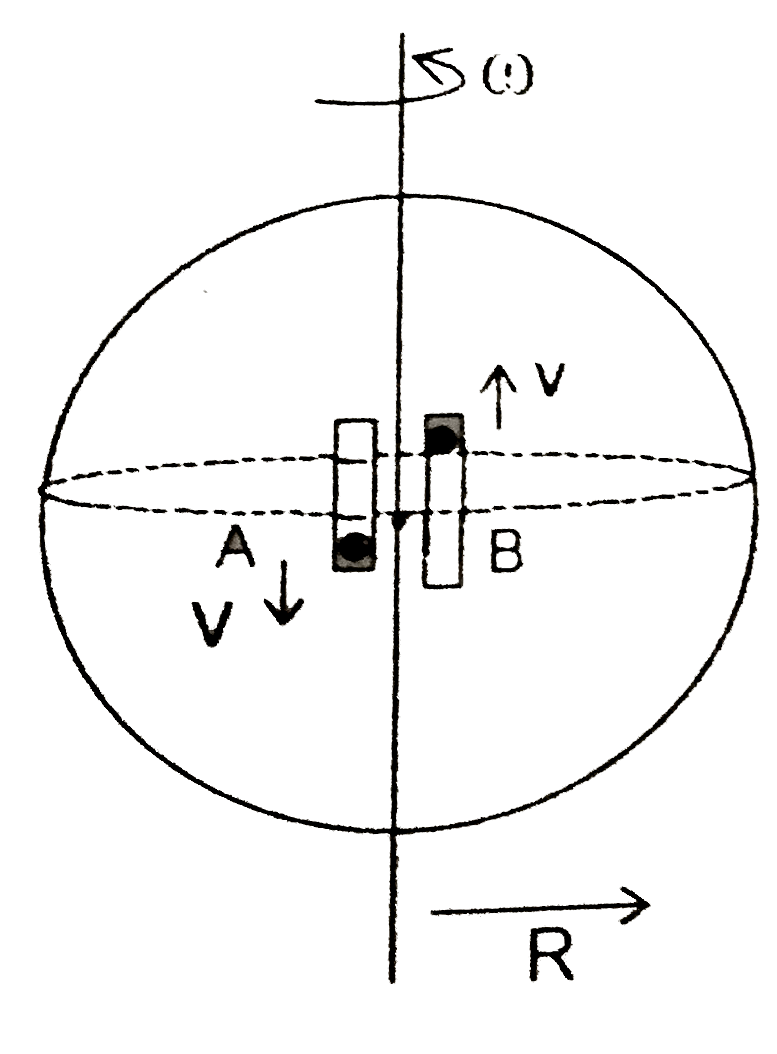If orbit velocity of planet is given by v=GaMbRc, then
a=13,b=13,c=−13
a=13,b=12,c=−12
a=12,b=−12,c=12
a=12,b=−12,c=−12
The correct Answer is:B
To solve the problem of finding the values of a, b, and c in the expression for orbital velocity v=GaMbRc, we can follow these steps:
Step 1: Understand the formula for orbital velocity
The orbital velocity v of a planet is given by the formula:
v=√GMR
where:
- G is the gravitational constant,
- M is the mass of the planet,
- R is the radius of the orbit.
Step 2: Rewrite the formula in terms of powers
We can express the formula for orbital velocity in terms of powers of G, M, and R:
v=(GM)1/2R−1/2
This can be rewritten as:
v=G1/2M1/2R−1/2
Step 3: Identify the powers of G, M, and R
From the expression v=G1/2M1/2R−1/2, we can identify the values of a, b, and c:
- The exponent of G is a=12,
- The exponent of M is b=12,
- The exponent of R is c=−12.
Step 4: Write the final answer
Thus, the values of a, b, and c are:
a=12,b=12,c=−12
Summary
The final result is:
- a=12
- b=12
- c=−12
---
The orbital velocity v of a planet is given by the formula:
v=√GMR
where:
- G is the gravitational constant,
- M is the mass of the planet,
- R is the radius of the orbit.
We can express the formula for orbital velocity in terms of powers of G, M, and R:
v=(GM)1/2R−1/2
This can be rewritten as:
v=G1/2M1/2R−1/2
From the expression v=G1/2M1/2R−1/2, we can identify the values of a, b, and c:
- The exponent of G is a=12,
- The exponent of M is b=12,
- The exponent of R is c=−12.
Thus, the values of a, b, and c are:
a=12,b=12,c=−12
The final result is:
- a=12
- b=12
- c=−12
Topper's Solved these Questions
- GRAVITATIONBOOK - DC PANDEY ENGLISHCHAPTER - GRAVITATIONEXERCISE - (B) Chapter Exercises
31 Videos
- GRAVITATIONBOOK - DC PANDEY ENGLISHCHAPTER - GRAVITATIONEXERCISE - (C) Chapter Exercises
45 Videos
- GRAVITATIONBOOK - DC PANDEY ENGLISHCHAPTER - GRAVITATIONEXERCISE - Check Point 10.6
20 Videos
- GENERAL PHYSICSBOOK - DC PANDEY ENGLISHCHAPTER - GENERAL PHYSICSEXERCISE - INTEGER_TYPE
2 Videos
- KINEMATICSBOOK - DC PANDEY ENGLISHCHAPTER - KINEMATICSEXERCISE - INTEGER_TYPE
10 Videos
Similar Questions
The velocity v of a particle at time t is given by v=at+bt+c, where a, b and c are constants. The dimensions of a, b, c are respectively :-
View SolutionA planet is revolving around the Sun in an elliptical orbit. Its closest distance from the Sun is r and farthest distance is R. If the orbital velocity of the planet closest to the Sun is v, then what is the velocity at the farthest point?
View Solution
Knowledge Check
A planet is revolving in an elliptical orbit around the sun. Its closest distance from the sun is r and the farthest distance is R. If the velocity of the planet nearest to the sun be v and that farthest away from the sun be V. then v/V is
AR2/r2Br2/R2CR/rDr/R
If r is the total radius and v is the orbital velocity of an electron in a hydrogen atom, then its magnetic dipole moment is
View SolutionIf the radius of an orbit is r and the velocity of electron in it is v , then the frequency of electron in the orbit will be
View SolutionA projectile is projected tangentially from the surface of a planet of radius R. If it is at a height of 3R at the farthest point of its trajectory, then the velocity of projection V0 is given by ( acceleration due to gravity on surface=g)
View SolutionA planet is revolving around the Sun in an elliptical orbit. Its closest distance from the sun is rmin. The farthest distance from the sun is rmax if the orbital angular velocity of the planet when it is nearest to the Sun ω then the orbital angular velocity at the point when it is at the farthest distance from the sun is
View SolutionA planet is revolving round the sun in an elliptical orbit, If v is the velocity of the planet when its position vector from the sun is r, then areal velocity of the planet is
View SolutionIf v0 be the orbital velocity of an articial satellite orbital velocity of the same satellite orbiting at an altitude equal to earth's radius is
View Solution
Two trains A and B each of mass m are moving on a longitude of a spherical planet of mass M and radius R with velocity v relative to to planet. Train A & B presses thhe rail track with forces NA & NB respectively. [ω is angular velocity of planet about its vertical axis] Then
View Solution
